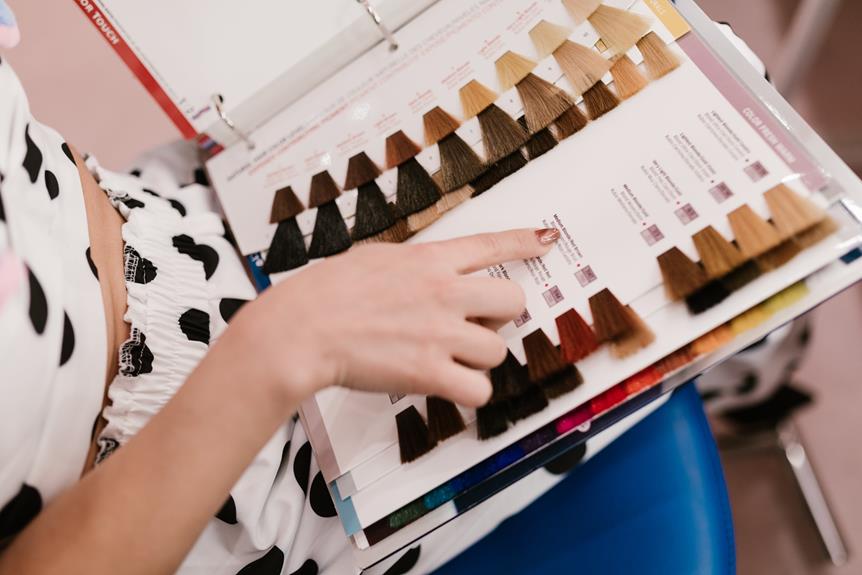Exploring the realm of color chart mastery unveils a world where precision meets creativity, and artistry intertwines with science. Through meticulous understanding and application of color theory, designers can orchestrate visual symphonies that resonate with viewers on a profound level.
The interplay of hues, shades, and tones offers an intricate tapestry waiting to be woven into captivating designs. Stay tuned to unravel the secrets behind expert advice for mixing and matching colors, unlocking the door to a realm where creativity knows no bounds and every hue tells a story.
Contents
Key Takeaways
- Harness color psychology for intentional emotional responses.
- Experiment with creative pairings for unique visual impact.
- Balance brightness and contrast for optimal aesthetics.
- Utilize texture to create dynamic visual experiences.
Project Purpose and Mood Consideration
In the realm of colour chart mastery, the initial step towards creating a visually impactful design involves astutely considering the project's purpose and the desired mood it aims to evoke.
For spaces intended to exude a calm ambiance, cool tones such as blues and greens can work wonders in instilling a sense of tranquility.
On the other hand, for areas meant to radiate energy and vibrancy, warmer shades like reds and oranges are ideal choices to create lively and energetic spaces.
Cohesive Color Combinations and Theory
Considering the impact of cohesive color combinations and the principles of color theory is essential for creating visually captivating and harmonious designs that resonate with viewers. Delving into color psychology insights and creative pairings can elevate the overall aesthetic appeal of a design. Understanding harmonious color schemes can greatly enhance the visual impact of a project.
Here are some key points to keep in mind:
- Color psychology insights can guide the selection process
- Creative pairings can lead to unique and engaging designs
- Harmonious color schemes ensure a cohesive look
- Visual impact is heightened with well-thought-out color combinations
- Experimenting with unexpected hues can result in striking visual outcomes
Contrast, Brightness, and Design Balance
Achieving optimal visual impact in design necessitates a delicate balance between contrast, brightness, and overall design equilibrium. When considering brightness contrast, pairing bright shades with muted tones can create focal points while avoiding overwhelming the viewer. It's essential to find a balance, ensuring that the design is visually stimulating without being jarring. Understanding hue temperature plays a crucial role in selecting contrasting shades that work harmoniously together. To illustrate further, consider the following table showcasing the interplay between brightness contrast and design harmony:
| Brightness Contrast | Design Harmony |
|---|---|
| Pairing Bright and Muted Tones | Balancing Visual Stimulus |
| Utilizing Hue Temperature Differences | Creating Cohesive Compositions |
| Avoiding Excessive Contrast | Ensuring Viewer Comfort |
| Selecting Contrasting Shades Thoughtfully | Achieving Optimal Visual Impact |
| Finding Balance in Design Elements | Enhancing Overall Aesthetics |
Texture Influence on Hue Perception
Texture plays a crucial role in how hues are perceived visually, influencing the overall aesthetic impact of a design. When considering texture and material in relation to hue perception, several factors come into play:
- Glossy vs. matte effects can alter the intensity of colors
- Material interaction nuances affect how hues are reflected and absorbed
- Light interplay with textures creates unique visual effects
- Natural materials may enhance certain hues differently than synthetic ones
- Combining textures can create a dynamic visual experience
Understanding these texture-related nuances can help designers make informed choices when selecting and combining colors for a cohesive and visually appealing outcome.
Utilizing Tools for Pairing Success
Enhancing color combinations through strategic tool utilization is key to achieving visual harmony in design projects. By incorporating color wheel techniques and design psychology, designers can elevate their work to new levels.
Creative experimentation and unexpected pairings can lead to exciting and innovative outcomes that captivate viewers. Utilizing tools like the color wheel allows for a systematic approach to pairing colors effectively based on their relationships and contrasts.
Understanding the psychological impact of different color combinations can help create designs that resonate with the intended audience on a deeper level. By embracing these techniques and principles, designers can push boundaries, break away from traditional norms, and create visually stunning compositions that leave a lasting impression.
Breaking Design Rules for Impact
Embracing unconventional approaches to color pairing and design execution can lead to impactful and memorable creations that defy traditional norms and captivate audiences on a deeper level.
- Unconventional pairings can evoke strong emotions and intrigue
- Design impact is heightened through unexpected color choices
- Daring combinations can spark creativity and conversation
- Breaking design rules challenges perceptions and stirs interest
- Pushing boundaries often results in unique and unforgettable designs
Feedback and Portfolio Importance
Understanding the significance of seeking feedback and maintaining a portfolio is crucial for fostering growth and success in the realm of design. Feedback benefits designers by providing fresh perspectives and insights, aiding in refinement and improvement. Additionally, a well-curated portfolio showcase allows designers to demonstrate their skills, creativity, and unique style to potential clients and employers. It serves as a visual resume, highlighting past projects and accomplishments. Here is a table showcasing the key benefits of feedback and the importance of a portfolio:
| Feedback Benefits | Portfolio Showcase |
|---|---|
| Offers fresh perspectives | Demonstrates skills and style |
| Provides insights for improvement | Showcases past projects |
| Fosters growth and learning | Highlights accomplishments |
Frequently Asked Questions
How Does Cultural Background Influence Color Preferences in Design?
Cultural influences play a significant role in color preferences in design, shaping perceptions and emotions. Understanding the impact of cultural background on color choices is crucial for creating designs that resonate with diverse audiences and evoke desired responses.
What Role Does Color Psychology Play in Branding and Marketing Strategies?
Color psychology plays a pivotal role in branding and marketing strategies, influencing consumer behavior and emotional responses. Effective product packaging and advertising leverage hues to evoke specific feelings, creating memorable experiences that resonate with target audiences and drive sales.
How Can Color Choices Impact the Perceived Size and Layout of a Space?
Color perception in spatial design is crucial. Strategic hues impact room layout perception. Lighter shades expand spaces, while darker tones create coziness. Contrasting walls can visually separate areas. Thoughtful color choices redefine and enhance spatial experiences.
What Considerations Should Be Made When Selecting Colors for Individuals With Visual Impairments?
When selecting colors for individuals with visual impairments, accessibility considerations are paramount. Focus on high color contrast to aid in distinguishing elements. Brightness, saturation, and hue differentiation play key roles. Consult color experts for optimal choices.
How Can Historical Color Trends and Movements Influence Contemporary Design Choices?
Fashion evolution often mirrors art movements, embracing color symbolism. Historical trends influence contemporary design by inspiring innovative color choices. Understanding color theory and cultural contexts from the past enriches modern creations, creating a bridge between tradition and innovation.
Conclusion
In conclusion, mastering color charts is a vital skill for designers seeking to create visually captivating and emotionally resonant projects.
By understanding color theory, balance, and the psychological impact of hues, designers can craft spaces that evoke specific moods and leave a lasting impression on viewers.
Remember, the power of color is limitless and can transform any design into a masterpiece that defies expectations and stirs the soul.







